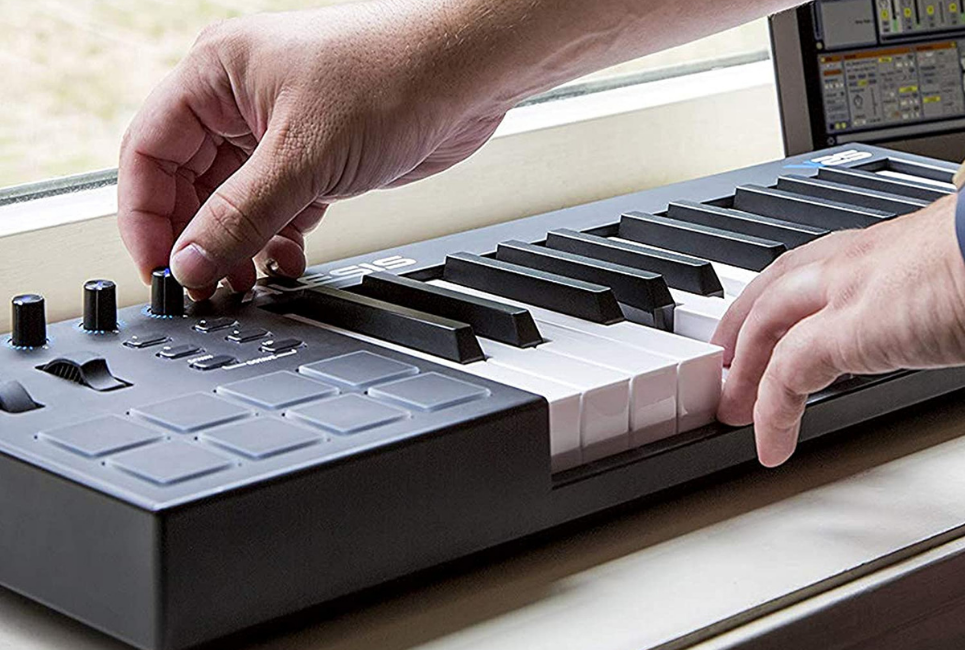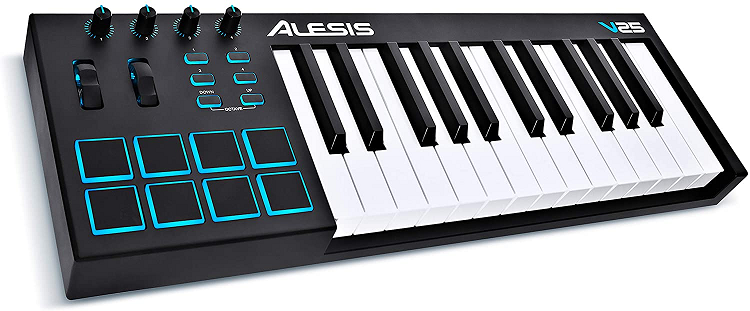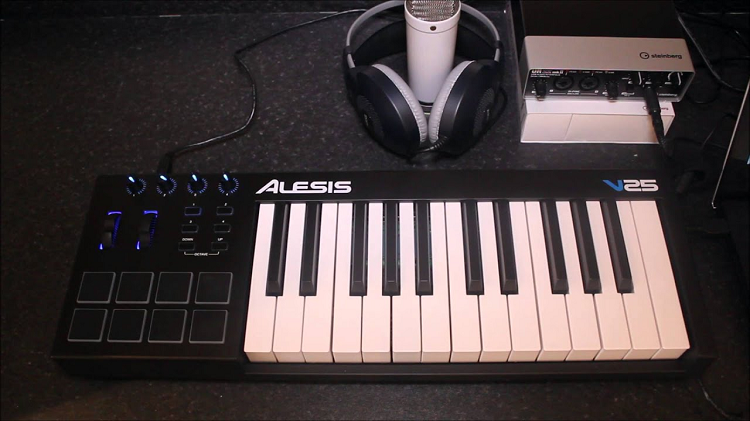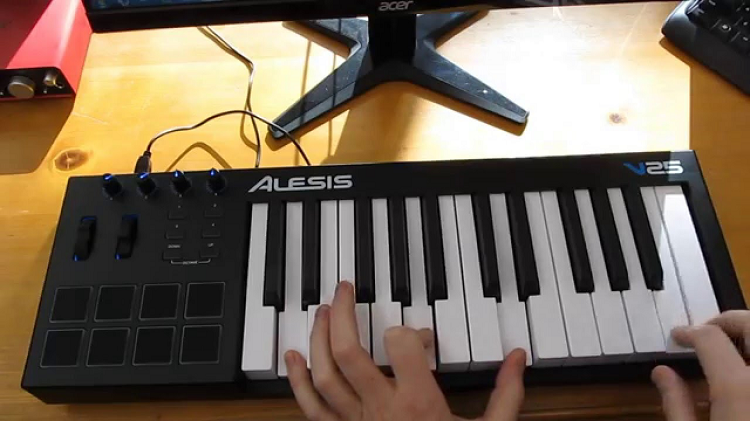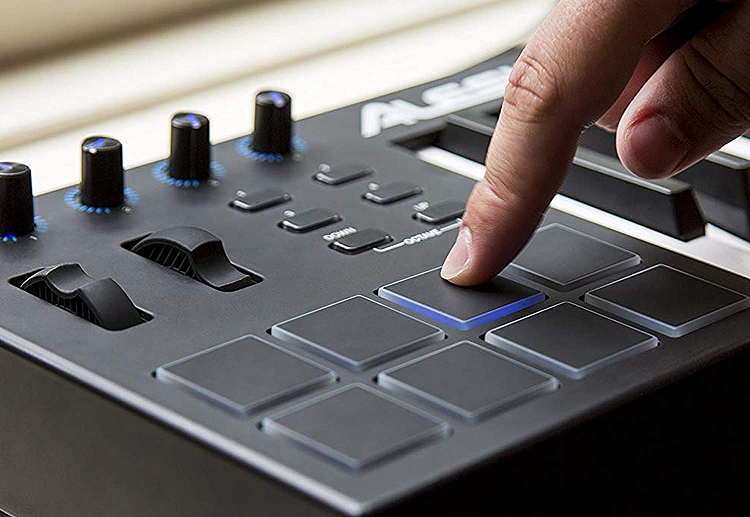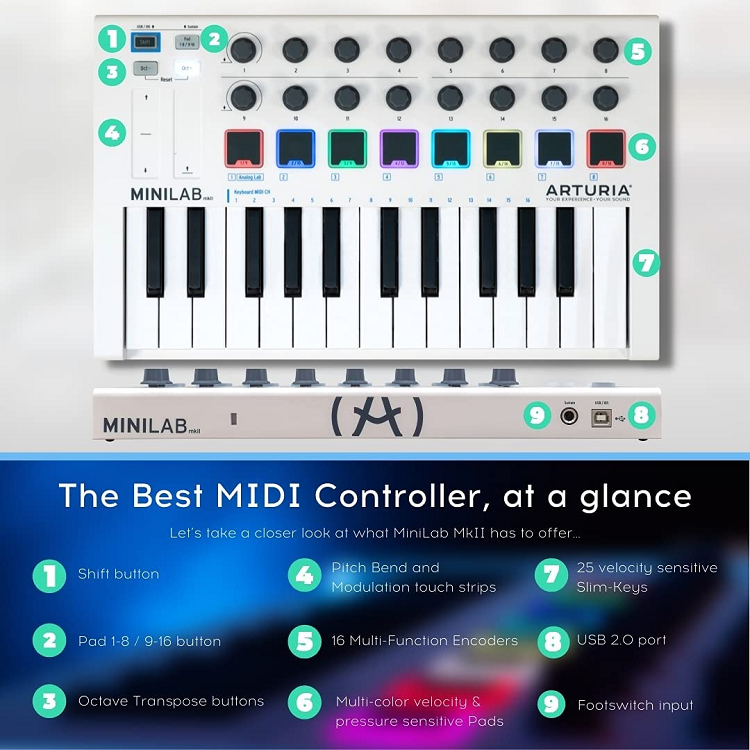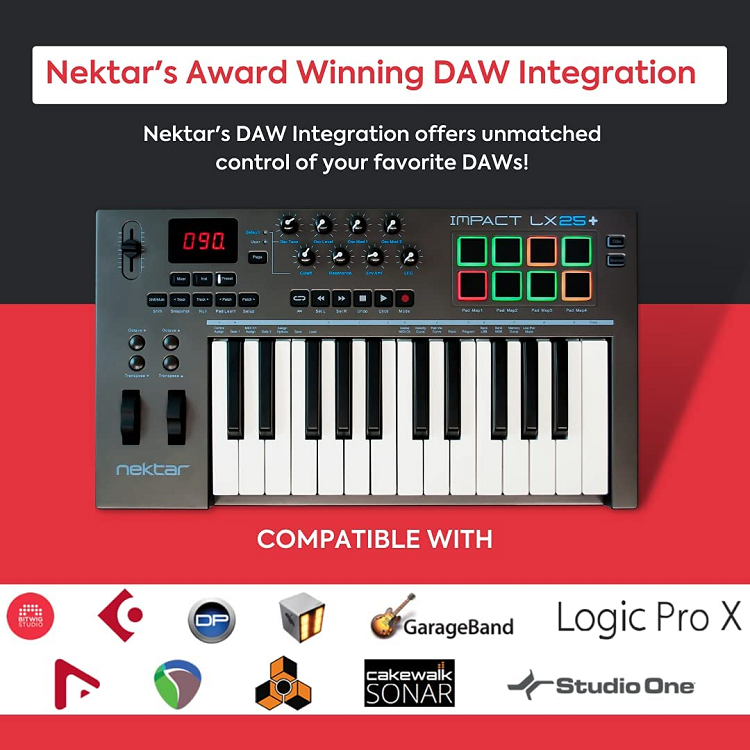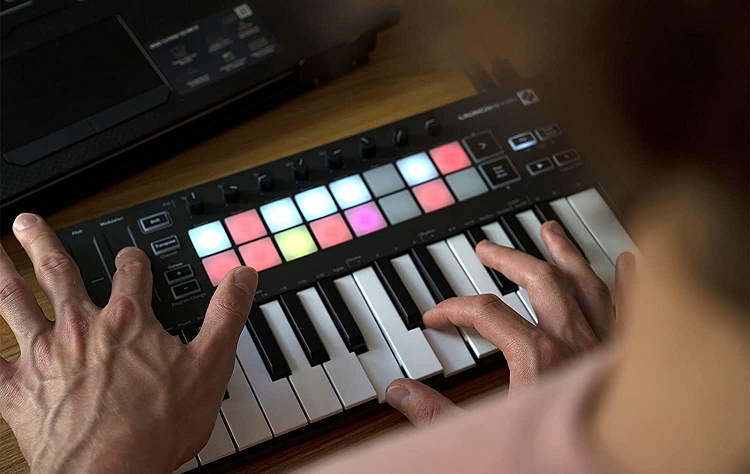- Lights, Camera, and Action: How to Film and Edit a Drum Cover - May 31, 2022
- The Best Wuhan Cymbals: A Comprehensive Buying Guide - May 30, 2022
- Alesis Surge vs Command Compared - April 26, 2022
Whether you’re an aspiring music producer, DJ, or musician, the odds are that a MIDI keyboard controller is one of the most common tools you use to pursue your musical passions.
Choosing an appropriate MIDI keyboard to buy can be a challenge, though. There are many different MIDI keyboard models around, with varying features and price points.
While browsing through the offerings of recently released 25-key MIDI keyboards, the one that caught my eye was the Alesis v25. While not as well known as some other brands, the Alesis v25 offers a very solid list of features for its retail price.
Even better, at the time of writing, the Alesis v25 is surprisingly affordable. This makes it a steal for any budget-conscious or beginner music producer or DJ looking for a portable yet well-featured MIDI keyboard.
Of course, choosing a MIDI keyboard is an incredibly important decision in starting your music career, which is why I’ve also included some tips on how you can make your ultimate decision. There are plenty of other fantastic options to choose from at this price point for a 25-key MIDI keyboard, which I’ve included below.
That being said, for most beginner and general use cases, I think almost everyone looking for a small and portable MIDI controller will be satisfied with the features and feel of the Alesis v25. I personally definitely recommend it as a fantastic budget option.
How to Choose A MIDI Controller: Some Key Decision-Making Tips
When choosing a MIDI controller, it can be easy to get lost in the sea of different models, prices, features, and sizes. While it can be exciting to explore all the different options out there, it’s important that when you finally choose which one to purchase, you do so with your intended use case and budget in mind.
Not everyone needs a full-fledged, thousand-dollar, 88-key, weighted hammer action keyboard – especially if portability is important to you. With that in mind, here are the top considerations you need to think about when choosing which MIDI keyboard you want to buy:
- Its Size
- The Keyboard Action
- Its I/O Options
- The Performance Pads
The Keyboard’s Size
MIDI keyboards come in 25, 49, 61, and 88-key models, which determine how long the overall keyboard is. While it may be tempting to choose a large keyboard for the versatility of having more keys to work with, it’s important to keep in mind how you plan to use your keyboard.
For instance, if you play two-handed or want to be able to do keyboard splits, a keyboard with more keys may be better suited for your purposes.
On the other hand, if you just want something small that you can carry around and travel with (or if you have limited space in your studio), then a long 88-key MIDI keyboard can be a poor waste of money.
In general, a 25-key MIDI keyboard is ideal if you plan on taking your keyboard with you onto the road, particularly if you usually take public transit or some other communal transportation. They also have the benefit of generally being the cheapest of MIDI keyboard sizes.
These keyboards are small enough that they can practically be used on any desk or work environment, but they come at the cost of fewer keys. In turn, this means fewer ways you can use the keyboard in your music.
If you’d rather not limit yourself to a 25-key keyboard, though, consider a 49-key or 61-key MIDI controller instead. If you have the studio space and you don’t plan to travel much, or you have a van or personal vehicle to transport your equipment, then an 88-key keyboard offers the greatest versatility – though in a much larger package.
Its Keyboard Action
The key action, or keyboard action, refers to the way each key feels when you press down on them. Don’t dismiss this as unimportant, though. At the end of the day, the way your keyboard feels when you play factors greatly into how comfortable and enjoyable the use of your keyboard will feel.
This is particularly important if you spend a lot of time using a MIDI controller in one sitting. That being said, there is no hard and fast rule about which type of keyboard action is the most comfortable. Different people will prefer different keyboard feels.
Ultimately, it all largely depends on the kind of music you want to play or what kind of musical background you’ve trained with. In general, MIDI keyboards will have either:
- Weighted Hammer Action Keys
- Semi-Weighted Action Keys
- Synth-Action Keys
I’ve summarized and described these actions for you below.
Weighted hammer action keys try to replicate the feeling of a normal piano, which creates sound by pulling on a string connected to the key and moving a hammer to strike strings. Creating this effect artificially in a MIDI keyboard is difficult, as there are no physical moving parts or hammers inside a MIDI keyboard.
However, MIDI keyboard manufacturers are able to manipulate weights and springs to roughly simulate the effect. Some more expensive MIDI keyboards even include a genuine hammer action inside the keyboard, though it doesn’t connect with any strings.
This type of keyboard action is ideal for individuals who are used to playing the piano, or if they often compose music for the piano. It can also just feel more tactile and satisfying.
Semi-weighted action keyboards attempt to offer a similar feel when keys are pressed to the weighted hammer action keyboards, but they have less key resistance and more spring to the release of the key. This keyboard action is highly popular among users of MIDI keyboards, as well.
This is because they can feel more tactile without the excessive resistance that can sometimes be felt in weighted hammer-action keyboards when playing faster music. This keyboard action type is a kind of compromise between the feeling of an actual piano like the weighted hammer action keyboard and the synth-action keyboard, which feels much more electronic.
Speaking of which, the synth-action keyboard uses light, spring-loaded keys that are intended to allow players to play very fast-paced music. It does this by returning to position much more quickly compared to the other two types of keyboard action.
These keyboards tend to be popular with musicians who were never trained for the piano. The reason for this is that a synth-action keyboard sacrifices the feeling of a piano for a practical advantage in composing and playing fast-paced music.
The Keyboard’s I/O Options
As with any computer accessory, MIDI keyboards come with a variety of different input and output options in terms of ports and features. Almost all modern MIDI controller keyboards connect via USB, but different keyboards will have other jacks and connections available for different use cases.
5-pin MIDI DIN jacks will let you connect external MIDI instruments. These can include accessories such as your:
- Sound Cards
- External Synths
- Hardware Sequencer
- Drum Machine
As well as other useful additions, too. VC/Gate jacks, an older standard to control music devices that use an analog rather than a digital signal, can be found on some MIDI synths and keyboards. These allow high-resolution output and control for older synth gear that doesn’t use MIDI.
The Keyboard’s Performance Pads
Finally, you’ll need to decide whether or not you want a keyboard with built-in performance pads, as well as other features such as knobs and faders. Yes, these additions take up room on your keyboard that could otherwise be used for keys.
However, they also offer significant conveniences and advantages if you include a lot of percussion in your music. Plus, performance pads can also just feel better than using keys to play percussion. However, you’ll need to make sure that the additional size and hindrance to portability are worth it.
What are the Key Features of the Alesis v25?
Now that you know how to choose a MIDI keyboard let me turn your attention to the Alesis v25. This petite 25-key MIDI keyboard controller may not be from a company as well-known as M-Audio or Akai, but it comes with a wealth of features for its small size while remaining relatively light and portable.
That way, you can carry it with you in a bag or use it on a small desk with ease. Its relatively affordable price tag makes it an economic yet quality option when compared to other similar priced MIDI keyboard controllers, too.
Even just holding the keyboard, it feels lighter than most other 25-key MIDI controllers. At 5.4 pounds, the Alesis v25 is light enough to make up for the fact that it’s a bit wider than some other 25-key MIDI keyboards, though it should still easily fit into a bag or backpack.
Setting up the Alesis v25 was a wonderfully smooth and easy experience, as it’s just plug-and-play. Its modern USB interface makes it compatible with essentially any computer or laptop running semi-recent hardware, too, and it’ll work on both Windows and iOS.
You don’t need to install any drivers or hardware to use the Alesis v25, either. Your existing preferred music software should just detect it automatically.
Its Overall Performance: My Critique
Using the Alesis v25 also feels really great. Its keys are semi-weighted, which gives them a bit of bounce and tactile feel – not quite like an actual keyboard or even a weighted hammer action MIDI controller, but enough of a close imitation that musicians used to playing on a piano should find the Alesis v25 at least familiar.
The semi-weighted keys don’t feel as cheap as synth-action spring-loaded keys tend to feel, although that does mean that quick and fast-paced songs won’t be as convenient to play on this keyboard. I also didn’t have an issue with the default sensitivity settings of the Alesis v25, but some other customers have reported issues.
If you find that the keys need to be tweaked, the V-Series Editor software from Alesis makes it easy enough to adjust the velocity curves of the keys. There are also eight preset curves to pick from, including a flat velocity that doesn’t change no matter how hard you press the keys.
Unfortunately, you will need to download Alesis’ software to adjust the settings of the Alesis v25. Fortunately, since adjusting velocity curves doesn’t usually need to be done more than once, it shouldn’t be too much of a hassle.
The drum pads on the Alesis v25 are also a delight to use. They feel more pleasant than most other MIDI keyboards at this price range, with a subtle amount of resistance without feeling too stiff. The keyboard comes with eight drum pads, with an additional four pattern buttons for a total of 32 “pads” you can assign different notes to.
The pattern buttons make a great addition for a bit of extra versatility, even though most users won’t feel the need to go beyond eight pads at once.
While some users reported issues with the drum pads on early models of the v25, Alesis has published a firmware update since then, which seems to have fixed the issue. You can grab this update on their official website.
Alesis’s software also allows you to configure the velocity curves for the drum pads using the same eight presets available for the keys. And other than the keys and drum pads, the Alesis v25 also provides a pitch and mod wheel, which definitely feel serviceable and comfortable to use, albeit nothing remarkable.
Four rotary knobs at the top of the keyboard round out the selection of inputs and can be assigned to any MIDI channel you want with the V-Series Editor software. These dials rotate 270 degrees in each direction and can be used for filters or other musical effects.
The dials are backlit with a blue light, as are the drum pads and other buttons, which is a nice addition (particularly if you plan to perform or use the keyboard at night or in the dark).
Overall, I found my experience with the Alesis v25 to be highly enjoyable for a keyboard at this price point. While more expensive models certainly exist with better feeling keys and more features, it’s hard to beat the Alesis v25, particularly when it goes on sale.
The Features of the Alesis v25
Here are the main features and selling points of the Alesis v25:
- Twenty-five full-sized, square-front keys.
- Eight backlit pressure-sensitive and velocity drum pads for clip launching and beat production.
- Four assignable buttons, as well as four assignable knobs, make interfacing with your music software choice a breeze.
- A convenient pair of octave-up and octave-down buttons to provide you with the full range of a keyboard.
- Intuitive and easy-to-use pitch and modulation wheels that can allow you to control your music more precisely.
- Convenient backlighting for buttons and knobs to deliver visual feedback.
- Both USB power and USB-MIDI connectivity, which are compatible with both Mac and PC.
- User-friendly software is available for customizing and modifying the sensitivity of keys and pads.
- No need to install drivers – just plug and play!
Despite the praise we’ve given to the Alesis v25, though, no keyboard is perfect. Here are the pros and cons of the Alesis v25, so that you can choose a keyboard that’s right for you.
Pros
- At just 5.4 pounds, the Alesis v25 is light enough to be highly portable (despite its slightly larger-than-average size).
- The keys are full-sized despite being a mini MIDI keyboard controller, which means they won’t cramp your hands up while you play.
- Its semi-weighted key action makes the Alesis v25 a joy to play, with enough tactile feedback to feel reminiscent of an actual piano.
- The eight velocity-sensitive drum pads can be mapped using four pattern buttons for 32 virtual drum pads to use overall.
- Rotary knobs at the top of the keyboard allow a convenient and easy way of using effects and out common inputs, but without having to reach for your mouse
- A great value for the price, as the Alesis v25 is one of the most feature-rich 25-key MIDI controllers at this price point.
Cons
- The keyboard lacks transport controls, so you won’t be able to control a digital audio workstation (DAW).
- Its velocity settings require additional software to tweak, and the default settings might be too sensitive for some people.
- The pads are sometimes prone to double triggering, and they may require a firmware update out of the box to use properly.
The Alternatives We’d Also Recommend
While the Alesis v25 is a fantastic budget or introductory MIDI keyboard controller, there are other candidates that may serve you better depending on your needs and specific use cases. With that in mind, here are three of the best 25-key MIDI keyboard controllers for you to consider.
Each one comes with slightly different strengths and weaknesses than the Alesis v25. By evaluating the competition, you can be sure that you are able to purchase the best MIDI keyboard controller possible for yourself.
Arturia MiniLab Mk II 25 Slim-Key Controller
While the Alesis v25 offers fantastic price-to-feature value, for just a few dollars more, the Arturia MiniLab Mk II Slim-Key Controller provides stellar build quality in an incredibly feature-rich package. Designed specifically for portability, the Arturia MiniLab Mk II is slimmer than the Alesis v25.
However, the smaller size comes at the sacrifice of slim keys rather than standard full-size keys. The pitch and modulation wheel of the Alesis v25 is instead replaced with touch strips on the Arturia MiniLab Mk II, which may be a bit easier and more convenient to use depending on personal preference.
Unlike the semi-weighted keys on the Alesis v25, the Arturia miniLab Mk II uses synth-action keys. While less similar to piano keys, these keys offer quicker snapback, thanks to the spring-loaded nature of synth-action keys. In turn, this allows quicker beats to be played with more convenience.
Fortunately, the Arturia MiniLab Mk II makes up for its slim keys with an abundance of customizability using software, including third-party programs like Ableton. Its USB interface also allows quick and convenient connections to either a Windows or iOS computer too, without the need for pesky drivers or software to get started.
Pros
- Highly portable, thanks to its slim keys and sleek form factor.
- Extremely solid build quality, designed to last and feel good in the hands.
- Synth-action keys make it easier to play fast-paced beats and melodies.
- Very little deck flex during use.
- Pitch and modulation touch strips offer a convenient way to change sounds without reaching for your mouse or interacting with other hardware.
Cons
- Slim keys may feel awkward for those who are used to full-size keys and may take some getting used to.
- Synth-action keys may feel somewhat cheap or uncomfortable after long periods of time to some people.
Nektar Impact LX25+
Another great value at a similar price point to the Alesis v25, the Nektar Impact LX25+ is a great budget or beginner’s MIDI keyboard controller.
Boasting all of the features a new music producer or DJ would need, it includes 25 full-sized keys, eight backlit velocity-sensitive drum pads, and the necessary wheels to adjust the pitch and modulation.
The Nektar Impact LX25+ also has eight customizable rotary knobs in contrast to the Alesis v25’s four. The keyboard’s black chassis is also sturdy and well-made, although it’s a bit larger than some other 25-key MIDI keyboard controllers, making it slightly less portable. The keys, although full-size, are also synth-action rather than being weighted.
Depending on personal preference, this may not be ideal. The velocity curves of the keys can be easily adjusted, but the keyboard only offers seven presets to choose from, rather than the eight that tend to be more common for other 25-key MIDI keyboards. The velocity curves for the drum pads are also not adjustable, unlike the Alesis v25.
Speaking of the drum pads, however, Nektar has included a unique feature for mapping the pads to a function. This is what the company calls “Pad Learn.” The map just like hotkeys in a video game, and you can do this simply by first pressing a pad, then pressing the function or note you want the pad to correspond to.
Despite not being able to change the velocity sensitivity of the pads, the default setting is generally accurate and probably good enough for most people.
Overall, at usually a few dollars less than the Alesis v25, the Nektar Impact LX25+ offers great value for a 25-key MIDI keyboard. Of course, the Alesis v25 probably beats it (especially if you can find it on sale).
Pros
- Full-sized keys and eight rotary knobs make the Nektar Impact LX25+ highly convenient to use.
- Comes with a free license for third-party customization software, rather than relying on proprietary solutions.
- Synth-action keys make it easier to play fast-paced beats and melodies.
- The well-equipped central control panel helps to streamline your music production.
- Its pitch and modulation wheels offer a convenient way to change sounds, but without needing to reach for your mouse or interact with other hardware.
Cons
- Its build quality suffers slightly due to its low price, and the controls tend to wobble a little (and even feel slightly cheap).
- To some people, the synth-action keys may feel cheap or uncomfortable after a while.
- Pressure sensitivity customization is lacking, especially for the drum pads.
- The footprint of its chassis is a bit bulky, making it difficult to fit it comfortably into bags or backpacks.
Novation Launchkey Mini MK3 25-key Keyboard Controller
Novation is a well-known brand with a long history of crafting excellent MIDI keyboards. The Novation Launchkey Mini MK3 is primarily designed to be used with Ableton Live software, but it should be compatible with most other music software, as well.
With a highly compact chassis, the Novation Launchkey Mini MK3 is highly portable, though that’s tempered slightly by the fact that it comes with a foot pedal. This addition is both a boon for versatility and a downside for having one additional accessory for you to have to lug around.
Nevertheless, the Novation Launchkey Mini MK3 is very well built, feeling both sturdy and solid while being used. It’s also very feature-rich, with sixteen velocity-sensitive drum pads in comparison to the Alesis v25’s eight. It also comes with a pitch bend and modulation touch strip too.
It connects to both Microsoft Windows and iOS systems via USB, although the keyboard controller also contains a MIDI output port. This allows for it to operate in standalone mode. Unfortunately, this functionality requires a special adaptor, which is sold separately by Novation.
Still, the standalone mode is a nice touch, and it’s particularly augmented by the inclusion of onboard amp and fixed chord modes. Both of these are also readily available when connected via MIDI adapter too.
The keys on the Novation Launchkey Mini MK3 once again use synth-action keys, in contrast to the Alesis v25’s semi-weighted action keys. The keys are also mini-sized, which can cause cramping for players who are more accustomed to full-sized keys.
Nevertheless, the fairly affordable price tag, combined with the additional functionality and included sustain pedal, make the Novation Launchkey Mini MK3 a decent alternative to the Alesis v25. At least, that’s true when neither is on sale – provided that the additional features are important to you, of course.
Pros
- The MIDI port output and standalone mode offer an additional way to use your MIDI keyboard compared to competitors.
- Sustain pedal allows for greater versatility when playing or composing music.
- Its synth-action keys make it easier to play fast-paced beats and melodies.
- The keyboard has sixteen drum pads, double the number of pads usually found in 25-key keyboards
- Its pitch and modulation touch strips offer a convenient way to change sounds without reaching for your mouse or interacting with other hardware.
- The good build quality ensures that the keyboard feels sturdy in the hand when using it.
Cons
- Primarily designed for use with Ableton Live software, so other music software may not connect as easily.
- Included sustain pedal makes the keyboard a little less easy to travel with.
- The MIDI output requires an additional adaptor, which also happens to cost extra.
Frequently Asked Questions
Answer: Yes! While it’s most common to connect a MIDI keyboard controller to a computer to process the MIDI audio signals, you can also connect a MIDI keyboard to a different device that can process and produce audio, such as an amplifier or a MIDI Audio Interface device.
It’s important to remember that a MIDI Keyboard Controller doesn’t actually produce sound like a real instrument, though. Rather, it simply creates digital MIDI signals. You’ll need a different device, as well as a speaker, to interpret and produce sound waves.
Answer: While Ableton Live is one of the most popular brands of software to use with a MIDI keyboard controller, you can use any digital audio workstation with most MIDI keyboard controllers.
Even free software, such as Garageband, should be compatible with your MIDI keyboard controller. It’s simply a matter of preference for which music software you prefer to use and work in.
Answer: It doesn’t. A MIDI Keyboard Controller isn’t an actual instrument in the sense that it produces sound waves in response to your fingers pressing down keys like a real piano would.
Instead, your MIDI Keyboard Controller simply produces a MIDI signal that travels via a USB cord to another device (such as a PC or an amp) that then processes and produces an audio signal.
Question: Can I Connect a MIDI Keyboard Controller to Speakers?
Answer: In general, MIDI keyboard controllers are usually connected to computers to record audio signals. However, you can also connect your MIDI Keyboard to an amp or other MIDI audio interface.
Then you can have it output sound signals to a set of speakers or headphones if you want to just use your MIDI Keyboard Controller as an instrument.
My Final Thoughts
MIDI keyboard controllers are one of the most versatile and useful pieces of equipment for any burgeoning music producer, DJ, or musician. A MIDI keyboard can help you to compose and record music or even manipulate music live.
While there are many types, models, and price points to choose from when picking a MIDI keyboard controller, your individual needs can vary. While I do definitely recommend the Alesis v25, by following our tips and advice, you can hopefully pick out the right MIDI keyboard controller that works for you and your needs.
Remember though: when picking any product, it’s not necessarily the features or price that you should worry about. Instead, pick a product that’s best suited for your own needs, although you should also keep your budget in mind.
The Alesis v25 is a fantastic choice for most use cases in this regard, as it’s highly affordable in its class and offers a comfortable balance between size, features, and portability.
That said, I’ve also provided a list of other excellent MIDI keyboards to choose from in case they work better for your particular niche and use case. It’s important that you choose the best MIDI keyboard controller for yourself. That way, you can make epic music at your very best.

